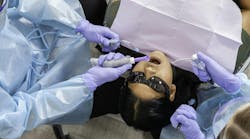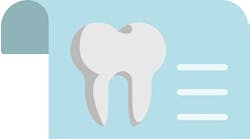Mindy Gil, DMD, is a periodontist in Newnan, Georgia. She has an interest in infection prevention and patient safety in her practice and has done much research on things like waterline and evacuation line maintenance. We spoke to her about her thoughts on this issue in dentistry.
Dr. Joshua Austin: Dr. Gil, you seem to have a passion for patient safety. Where did that passion come from?
Dr. Mindy Gill: Because I am a periodontist, most of my patients are older adults. Many patients have medical comorbidities such as autoimmune diseases, hypertension, diabetes, debilitating neuropathies, high cholesterol, history of surgeries, etc. In short, I have many medically compromised patients. Some are relatively well managed by conventional medicine. Some are still searching for help despite numerous doctors’ visits, medicine, imaging, and everything else in between. Furthermore, most patients do not enjoy their visit to the dentist, but they are here either because they have to be, or because they see the value in helping themselves before the pain forces them. They are trusting their health to us. For all these reasons, patient safety is absolutely priority number one.
Related reading ... Are you rinsing your patients with hot tub water?
JA: Very valid points. When we think of patient safety in a dental office, we immediately think of things like instrument cleaning and sterilization, surface disinfection, hand hygiene, etc. What are other areas of patient safety we should be thinking about?
MG: In addition to those, dental unit waterlines and suction lines are also critical areas we need to focus on to minimize the risk of cross-contamination.
JA: I think most of us are used to having our team treat waterlines. Outside of surgery, though, I am not sure many of us treat our suction lines. What have you found out about suction lines?
MG: Our dental evacuation systems (high speed and slow speed) remove blood, saliva, dental calculus, plaque, bloody tissues, suppuration, plumes from laser evaporation, and other debris while treating our patients. I imagine most dental facilities “run the line” at the end of each clinical day to remove buildups in the evacuation lines. We run our cleaner between all surgical patients, but it’s not practical to do so between each hygiene patient, in most circumstances. Although no adverse health effects associated with the saliva ejector have been reported, the Centers for Disease Control and Prevention cautions that backflow can occur in the following circumstances1:
- Pressure in a patient’s mouth is less than in the saliva ejector (i.e., when we tell our patients to close their mouth around the suction)
- Suction tubing attached to the ejector is positioned above the patient’s mouth
- A saliva ejector is used at the same time as other evacuation equipment
This backflow can be a potential source of cross-contamination. One study shows the probability of backflow happening is as high as 20%.2 In other words, one in five patients we treat could potentially be exposed to this backflow phenomenon.
JA: Wow, this is a sobering thought. I think we both accept the fact that the vast majority of dental offices are never going to clean/treat their suction lines after every single patient. What can we do to simply mitigate these risks?
MG: One way to address the concerns over backflow when using saliva ejectors is to use a physical one-way valve. One such solution is called Safe-Flo Saliva Ejectors and Valves by HuFriedyGroup. They can be added to your current system to provide backflow protection for your patients. Secondly, I actively tell my patients not to close their mouth around my suction, and that I will sweep the back of their throat periodically to catch any flowing liquid/debris.
JA: So simply by switching saliva ejectors, we can reduce this risk? That is insanely easy. Does this system reduce the amount of suction chairside?
MG: No, the manufacturer reports that the performance is not affected. Obviously, I have not measured quantitatively, but my personal experience reflects the same, and I have not noticed any reduction in suction power.
JA: Have there been any issues with your team or your patients with implementing Safe-Flo in your practice?
MG: It has been a smooth transition. Clinics have the option to get a fully assembled, all-in-one Safe-Flo Saliva Ejector and valve unit to replace their current saliva ejector. Or the other option is to easily add a Safe-Flo valve to your current saliva ejector or HVE tip to provide the same backflow protection.
JA: That sounds great. Where can readers get more information about Safe-Flo?
MG: Safe-Flo products are made by HuFriedyGroup and are widely distributed by many dental dealers. More information can be found at hufriedygroup.com/en/safe-flo, and you can request a sample as well.
Editor's note: This article appeared in the April 2024 print edition of Dental Economics magazine. Dentists in North America are eligible for a complimentary print subscription. Sign up here.
References
- Saliva ejector and backflow. Division of Oral Health. National Center for Chronic Disease Prevention and Health Promotion. Centers for Disease Control and Prevention. Reviewed March 3, 2016. https://www.cdc.gov/oralhealth/infectioncontrol/faqs/saliva.html
- Miller C. ‘Back flow’ in low-volume suction lines may lead to potential cross-contamination. RDH. January 1, 1996. https://www.rdhmag.com/infection-control/article/16406271/back-flow-in-low-volume-suction-lines-may-lead-to-potential-cross-contamination
Joshua Austin, DDS, MAGD, is a graduate and former faculty member of the University of Texas Health Science Center at San Antonio School of Dentistry. Author of Dental Economics’ Pearls for Your Practice column, Dr. Austin lectures nationally on products, dental technology, online reputation management, and social media. He maintains a full-time restorative dentistry private practice in San Antonio, Texas. You may contact Dr. Austin at [email protected].








